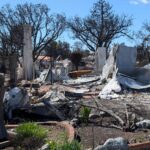Protecting Homes in Wildfire-Prone Areas
The 2025 Palisades Fire and Eaton Fires devastated parts of Southern California. The magnitude of acres scorched and the quick spread of the fires, underscores the urgent need for reexamining how we build fire-resistant homes. Delays in access to emergency services, water being offline, and decades-old infrastructure problems, combined with the high winds and a low-rain, winter created the environment for these deadly wildfires. In wildfire-prone areas in California, homeowners must take proactive steps to protect their properties from future events. Whether building a new home or retrofitting an existing one, adopting fire-resistant construction techniques is key to safeguarding your family and property. From selecting the right materials to smart landscaping choices, these recommendations can help to create a more resilient and safer home.
1. Defensible Space: Create a Buffer Zone Around Your Home
Defensible space refers to the concept of creating an area around your home that is kept clear of flammable material. This discourages the rapid spread of fire and can prevent fire from reaching the house. The area is divided into three zones:
- Zone 1 (0-5 feet): The area closest to your home should be free of any flammable materials. Use non-combustible materials such as gravel or stone for walkways and patios, and opt for fire-resistant plants like succulents and low-growing ground covers. Especially keep combustible materials like firewood away from the home.
- Zone 2 (5-30 feet): Plant shrubs and trees here, but choose fire-resistant native plants that are more resistant to flames and have higher moisture content. Space out the plantings to inhibit the spread of fire. Trim tree branches and regularly remove dead plants.
- Zone 3 (30-100 feet): Larger trees and vegetation can be planted in this zone but should be spaced to reduce fire hazards. Regularly clear away dead plants and create firebreaks by removing dense underbrush.
Additionally, consider installing a concrete perimeter wall instead of a wooden fence to create an additional firebreak.
2. Fire-Resistant Roofing Materials
The roof is one of the most vulnerable areas during a wildfire since embers can easily ignite some roofing materials. Consider these fire-resistant options:
- Metal Roofing: Durable and non-combustible, metal roofs can withstand high heat and flying embers.
- Clay or Concrete Tiles: These materials offer great fire resistance and longevity.
- Class A Asphalt Shingles: Opt for Class A-rated asphalt shingles, which provide the highest fire resistance.
- Slate: A beautiful and fire-resistant material, slate offers both aesthetic appeal and protection. Flat roofs could have a tiled roof deck.
- Green Roofs: These roofs, with a layer of soil and plants, can be irrigated to create a barrier between the fire and the roof.
3. Fire-Resistant Siding and Walls
The exterior walls of your home should be constructed with fire-resistant materials. Good choices include:
- Fiber Cement Siding: Non-combustible and resistant to high heat, fiber cement siding is an excellent option.
- Stucco: When properly applied with a fire-resistant underlayment, stucco offers good fire protection.
- Concrete and Brick: Both materials are naturally fire-resistant and provide added insulation, keeping your home cooler in summer and warmer in winter.
- Steel Siding: Non-combustible and weather-resistant, steel siding is another fire-resistant option.
Ensure that any siding material is properly installed with no gaps or exposed openings to prevent embers from getting inside.
4. Fire-Resistant Windows and Doors
Windows and doors are vulnerable to wildfires since glass can shatter under intense heat. This then allows flames and embers to enter inside the home. To reduce this risk, use:
- Tempered Glass: Stronger than regular glass, tempered glass can withstand higher temperatures and is less likely to break during a fire.
- Fire-Rated Windows: These windows are designed to withstand heat and prevent flames from entering the building envelope. They are often constructed using multiple layers of glass with fire-resistant materials between them.
- Metal or Fire-Rated Doors: Opt for metal, steel, or other fire-resistant materials for exterior doors instead of wood. Avoid wooden doors, as they are highly flammable. Adding metal shutters or fire-resistant screens to windows can further enhance protection.
5. Fire-Resistant Insulation and Interiors
Fire-resistant insulation can help slow the spread of flames inside your home. Options include:
- Fiberglass Insulation: Non-combustible, fiberglass insulation reduces fire spread.
- Spray Foam Insulation: When treated with fire retardants, spray foam can offer added fire resistance.
For interior finishes, avoid highly flammable materials like untreated wood paneling or vinyl flooring. Instead, opt for fire-resistant drywall, ceramic tiles, stone surfaces, or concrete flooring. These materials help prevent the spread of fire within your home.
6. Install a Fire Suppression System
A fire suppression system, particularly automatic sprinklers, can help prevent flames from spreading. Install sprinklers in high-risk areas such as the attic, roof, garage, and exterior. You might also want to consider adding a fire-resistant water tank on your property to supply water to the sprinklers or provide emergency firefighting capabilities.
Rebuilding for the Future
The devastation caused by wildfires like the Palisades Fire highlights the importance of preparing your home to withstand future fires. The first line of defense is keeping the fire out. Techniques such as a barrier zone of defensible space and using fire-resistant exterior materials for your roof, siding, windows, and doors, will help the fire to not breach the home’s exterior. Fire-resistant insulation and other interior materials, along with installing a fire suppression system, can significantly reduce the risk of damage from wildfires. Building a fire-resistant home requires thoughtful planning. Using the right materials, and being proactive with maintenance will help to ensure the safety of your home and loved ones from the growing threat of California wildfires.





